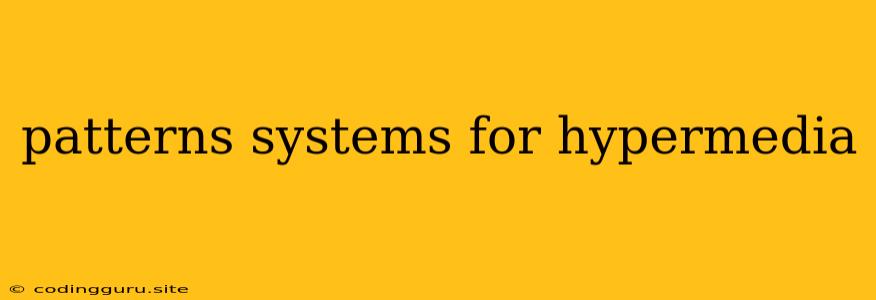Understanding Patterns and Systems for Hypermedia
Hypermedia, a powerful concept that transcends the boundaries of traditional media, holds immense potential for enriching user experiences. But harnessing its full potential necessitates a structured approach, particularly when developing complex applications. This is where patterns and systems come into play, providing a framework for building robust, maintainable, and engaging hypermedia experiences.
What are Patterns and Systems in Hypermedia?
Patterns in hypermedia serve as reusable solutions to recurring design problems. They offer proven strategies for structuring hypermedia content, handling navigation, and managing user interactions. These patterns can be applied to various hypermedia scenarios, ensuring consistency, efficiency, and a predictable user experience.
Systems, on the other hand, represent the overarching architecture and framework for hypermedia development. They define the fundamental principles, structures, and components that govern the creation and deployment of hypermedia applications. These systems provide a robust foundation for large-scale projects, facilitating collaboration and promoting scalability.
Why are Patterns and Systems Important for Hypermedia?
Imagine building a complex hypermedia application without any guidance. The result could be a chaotic and confusing experience for users. This is where patterns and systems come to the rescue. They offer several benefits:
- Improved User Experience: By providing a consistent and predictable structure, patterns enhance user navigation and information discovery. Users feel comfortable navigating the system, reducing frustration and leading to increased engagement.
- Increased Maintainability: Well-defined patterns and systems promote code reuse and modularity, making it easier to maintain and evolve the hypermedia application. This reduces development time and effort, enabling teams to focus on innovation.
- Enhanced Collaboration: Shared patterns and systems provide a common language for developers and designers, fostering better communication and streamlining the development process.
Common Hypermedia Patterns
Several patterns have emerged as effective solutions for common hypermedia challenges:
- Resource-Based Design: This fundamental pattern structures content around resources, each representing a distinct entity or concept. This approach promotes organization, facilitates resource discovery, and simplifies navigation.
- State Machines: Hypermedia can be effectively modeled as state machines, enabling transitions between different states based on user actions. This pattern provides a structured way to handle navigation and manage user interactions.
- RESTful APIs: Representational State Transfer (REST) provides a widely adopted architectural style for hypermedia applications. RESTful APIs utilize HTTP methods (GET, POST, PUT, DELETE) for interacting with resources, enabling seamless integration and interoperability.
Hypermedia Systems and Frameworks
Several systems and frameworks have been developed to facilitate hypermedia development:
- HATEOAS (Hypermedia as the Engine of Application State): This architectural constraint emphasizes using hyperlinks to navigate and discover application state. HATEOAS promotes a client-driven approach, enabling users to explore the application dynamically.
- JSON-LD (JSON for Linking Data): This standard facilitates the semantic representation of data in JSON format, enabling richer interoperability and data exchange across systems.
- Hydra: This API description format specifically designed for HATEOAS-compliant APIs. Hydra provides a structured vocabulary for defining resources, relationships, and supported operations.
Conclusion
Patterns and systems are essential tools for building robust, scalable, and engaging hypermedia applications. By leveraging proven patterns and implementing well-defined systems, developers can create hypermedia experiences that are user-friendly, maintainable, and capable of harnessing the full potential of this powerful technology. As hypermedia continues to evolve, understanding these patterns and systems will become increasingly critical for building the next generation of interactive experiences.
